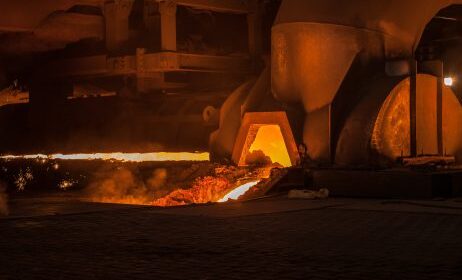One of the highlights of this year’s U.N. Climate Change Conference, COP26, has been that over 40 countries pledged to phase out coal from the power sector. However, beyond power generation, some of the most heavy-polluting, fossil fuel-reliant industries are steel, iron, cement, and concrete – the same industries that are crucial to aspirations of development in Asia and beyond.
While developed countries have moved away from the secondary economy (manufacturing) to the tertiary economy (services), developing countries are expected to witness rapid growth in infrastructure projects in the coming years. The International Energy Agency (IEA) has noted that as the populations and GDPs grow in developing countries in South Asia, Southeast Asia, and Africa, demand for steel, cement, and concrete will increase.
The focus on a just transition for cleaner energy and the rapid phase-out of coal has been at the heart of COP26, and is seen as crucial in the attempt to limit global temperature increases to 1.5 degrees Celsius in accordance with the Paris Agreement. However, the focus on the power sector meant the second largest source of carbon emissions – heavy industry – didn’t attract enough attention.
Iterating the concerns of many other developing countries, a Bangladeshi delegate at COP26, Jarin Tasneem Oyshi, an environmental engineer and researcher with BRAC University, said, “Bangladesh is a developing country and has budget constraints. It’s difficult for the government to invest in green technologies while we struggle to provide enough social services and basic facilities to our population.”
After the power sector, heavy industry is the largest source of carbon emissions, accounting for 27 percent of all CO2 emissions worldwide. Within heavy industry, the single largest emitter is cement, followed by iron and steel and petrochemicals. The four materials prominent in infrastructure development – steel, cement, aluminum, and chemicals – are responsible for 60 percent of current industry emissions. According to the IPCC, the global construction sector alone will be responsible for emitting 470 billion tonnes of carbon dioxide by 2050.
Global demand for steel is projected to continue to increase by more than a third through 2050, driven by emerging economies such as those in South and Southeast Asia, where high populations require more infrastructure construction. Moreover, predictions hold that global cement demand will grow by 12-23 percent by 2050 as compared to 2014, and steel demand might shoot up by 15-40 percent by 2050.
The carbon emission from these surging sectors might be more than the remaining carbon budget to limit global warming to 1.5 C.
Adding to the problem, these industries are difficult to make more environmentally friendly. Using renewable energy for the production of steel, for example, has its own challenges.ADVERTISEMENT
“India produced 111 million tonnes of steel in 2019. To produce an equivalent amount of green steel we would need 264 GW of solar energy,” said Hemant Mallya, senior program lead at the Delhi-based Council on Energy, Environment and Water. “India has an installed capacity of just over 100 GW of renewable energy, primarily for the power sector.”
“Every ton of green steel requires an investment of $3 billion,” Mallya added. “Financing industrial decarbonization presents its own challenges.”
“Heavy industries like cement, steel, and chemicals not only burn fossil fuels to generate heat, but also use them as chemical feedstocks,” explained Ulka Kelkar, director of the climate program at the World Resource Institute. “While energy use emissions can be mitigated by using more renewable electricity, process emissions are very hard to reduce because very few viable alternative technologies exist,”
During COP26, the First Movers Coalition was launched, which aimed to harness the collective purchasing power of global companies to drive market demand for low-carbon tech. In another development during COP26, heavy industries announced a “ Glasgow Breakthrough” – a multilateral agreement with an aim of accelerating clean technology, which will cover the steel industry along with road transport, agriculture, hydrogen, and electricity.
“This is a forward-looking set-up, but there is still a lot that has to be discussed. The initiatives are great on paper, but it would be critical to see what they mean in terms of proper commitments and what they have signed up for,” said Johanna Lehne, senior policy adviser at Third Generation Environmentalism.
According to Mallya, “While green hydrogen is talked about, it is currently three times as expensive as natural gas and seven times that of coal per unit of energy. It might take a decade before green hydrogen can be cost-competitive in India.”
Commercial hydrogen plants are still in pilot phases even in developed countries. Lehne estimates that such technologies might be available in the market as early as 2025-2026. Matthew Gidden, a senior scientific adviser at Climate Analytics, predicted that developing countries might be the suppliers of such cleaner fuels.
“We might have to wait a few more years until investment stimulates enough motivation. That is a continuous question, if it is viable,” said Hines.
Mallya of CEEW, however, warned that a transition cannot be understood as binary. “It’s not as simple as green or not green. There is no broad brush solution and that is precisely the problem. The problem is that everyone is looking for a silver bullet, which does not exist.
“Two reliable options exist now, before we move to advanced technologies. Either we continue to use coal or switch to a much clearer fuel, i.e. natural gas, with a clear plan on a transition later.”ADVERTISEMENT
Mallya emphasized that natural gas is a fossil fuel but leads to 40 percent less carbon footprint when compared with coal in steel production.
Lehne sees a similar path toward greening heavy industry: “The new investments should go to cleaner production of steel. A swift transition to natural gas followed by transition to hydrogen will help in decarbonization of the sector.”
The “problems with phasing out coal is that the deadlines are very far off,” Gidden mentioned. “We have many pathways which need to happen in order to achieve this climate goal. We are not beyond that realm of possibility. It will mean rapid scaling up of novel technologies, rapid transition of power sector, secondly of transport sector, [and] thirdly industrial sectors. ”
“We will see a very rapidly changing energy system in a very different equilibrium. It would take a lot of work and effort.”
To make that transition possible, the developed world will need to do more to help make green options feasible for countries still focused on lifting their people out of poverty. “It’s really clear that it’s not only a concern for the Global South. The Global North has a lot of responsibility, to help with financing and technology transfer,” added Gidden. “What we see till now is mostly commitment by the Global North, and they have failed to deliver the promise of $100 billion in climate finance by 2020. They need to up that by a significant amount.”
“It is all of these aspects combined which will enable that transition. But we need all of them. Any of these pieces failing, will hamper our ability to reach our climate goals.”





